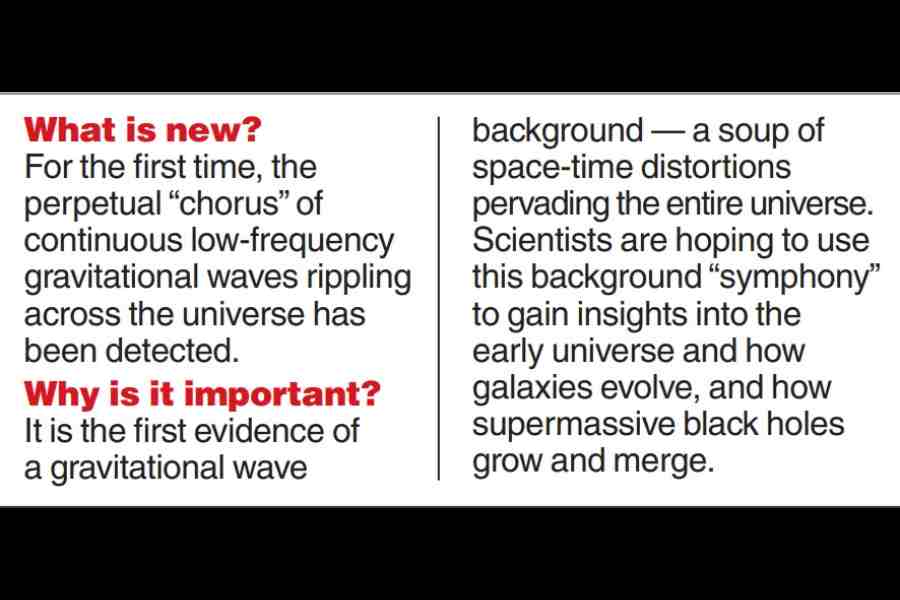A global research effort that includes astrophysicists in India has for the first time “heard” the perpetual “chorus” of gravitational waves continuously rippling across the universe — and it is louder than expected.
The international research consortium announced on Wednesday the first detection of the continuous low-frequency gravitational waves that astronomers believe emerge from pairs of supermassive monster black holes orbiting each other at distant sites throughout the universe.
The discovery is the first evidence for a gravitational wave background, what some scientists are calling a soup of feeble distortions in space-time pervading the entire universe. These long-lasting gravitational waves are distinct from the fleeting, high-frequency gravitational waves first detected in 2015 and that are caused by the mergers of black holes or dead stars.
“We’ve opened a new window of observation on the universe,” said Chiara Mingarelli, an astrophysicist and assistant professor at Yale University in the US, and a member of the North American Nanohertz Observatory for Gravitational Waves (NANOGrav) team.
Mingarelli likened the new class of gravitational waves to a “choir, with the pairs of supermassive black holes chiming in at different frequencies”. She also said the gravitational wave background was “about twice as loud as I’d expected”.
The NANOGrav team has published its findings in The Astrophysical Journal Letters.
One possible explanation could simply be heavier or more abundant supermassive black hole pairs but, Mingarelli said, there could also be other mechanisms, including alternative explanations of the universe’s birth.

In the search for the gravitational wave background, research groups in Asia, Australia, Europe, and North America used radio telescopes — including India’s upgraded Giant Metrewave Radio Telescope (uGMRT) near Pune — to study pulse-like signals from 68 pulsars, or dead stars spinning hundreds of times a second.
They documented subtle variations in the timing of the pulsars’ signals that result from the effect of the gravitational wave background. Scientists are hoping to use this background to gain insights into the early universe and into how galaxies evolve and how supermassive black holes grow and merge.
Scientists had first spotted gravitational waves — predicted by Albert Einstein a century ago — in 2015 using sophisticated laser-based giant instruments on Earth. Since then, physicists have documented over 90 gravitational wave signals — all of them produced during collisions of pairs of black holes or dead stars and all of them lasting only fractions of seconds.
“What had been detected earlier were like the crescendos or the loudest points in a symphony. We’re now hearing the base sounds, the softer but longer-lasting notes in the symphony,” said Pratik Tarafdar, a scientist at the Institute of Mathematical Sciences (IMSc), Chennai, a member of the Indian team.
Theoretical calculations had predicted that the collisions of supermassive black holes tens of millions of times more massive than the Sun would generate low-frequency gravitational waves that last longer than the stronger high-frequency waves detected earlier.
The weaker gravitational waves are generated as the supermassive black holes — typically found at the centres of galaxies — approach each other in spiral orbits that might last hundreds of thousands of years before their eventual collision.
“The calculations suggest that these ultra-low-frequency gravitational waves could last for months to decades as the supermassive black holes approach each other,” said Prerna Rana, an astrophysicist at the Tata Institute of Fundamental Research, Mumbai.
The Australian and US research groups initiated the experiment about 15 years ago and researchers from other countries joined the effort, contributing fresh data. Scientists at the National Centre for Radio Astronomy, Pune, began using the uGMRT to observe the pulsar signals.
“The idea of using pulsars in the galaxy as instruments to detect the waves was first proposed in the late-1970s, but it demanded high precision measurements impossible at the time,” said Manjari Bagchi, an astrophysicist and team member at the IMSc. ”The longer we make observations, the quality of the data gets better and better,” she said.
NANOGrav scientists had spotted what looked like hints of a signal in 2020 but the data was not strong enough to eliminate alternative explanations.
The global effort involved two radio telescopes in the US, five in Europe and one in Australia, besides the GMRT. “Our combined data will be much more powerful,” said Stephen Taylor, an astrophysicist at Vanderbilt University in the US and chair of the NANOGrav collaboration. “We’re excited about what secrets they will reveal about our universe,” he said in a media release.










